The Moto G (2015) Review
by Brandon Chester on August 19, 2015 8:00 AM EST- Posted in
- Smartphones
- Mobile
System Performance
Like the 2015 Moto E, the Moto G uses Qualcomm's Snapdragon 410 MSM8916 SoC. This is the first time Motorola has updated the SoC in the Moto G, with both the first and second generation models using the same 1.2GHz Snapdragon 400 SoC. Because the Moto G shares an SoC with the Moto E one might think this means they are equal in speed. However, the SKU in the Moto G has a peak frequency of 1.4GHz rather than the 1.2GHz in the Moto E. This is somewhat confusing because both are named MSM8916, but it's not dissimilar to how Snapdragon 615 devices run at either 1.5GHz or 1.7GHz on the big cluster.
As far as clock speed goes, the Moto G is 17% faster than the Moto E. It's difficult to estimate how much improvement will be seen compared to the older Moto G models, as the core architecture moves from Cortex A7 to Cortex A53 which comes with its own improvements in IPC in addition to the higher clock speed. It's also important to note that we are testing the model of the Moto G with 2GB of RAM, and this is another factor that can increase performance when comparing to Motorola's 1GB devices. Ultimately, it's important not to assume how much faster the Moto G will be based purely on the CPU frequency, even though it can give some idea about performance relative to other devices with the same CPU but a lower frequency. In order to properly characterize the Moto G's performance relative to many other devices, we turn to our standard workflow of web based benchmarks, followed by PCMark and BaseMark OS II.
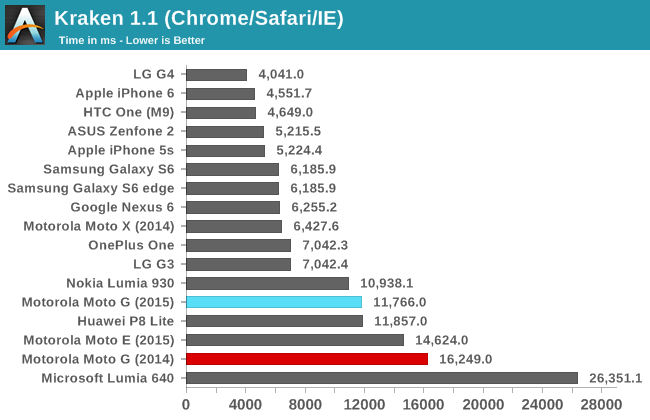
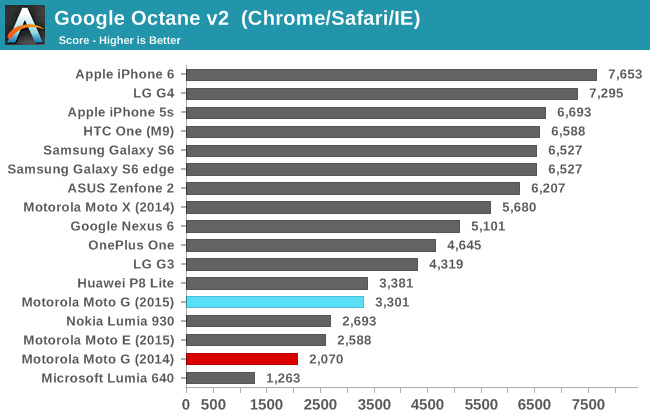
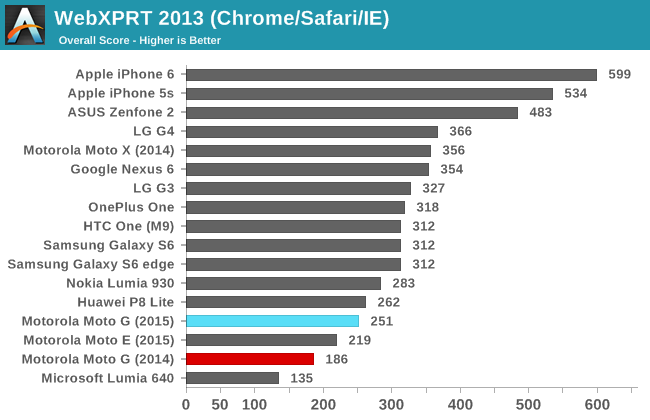

The overall picture painted by our web browser tests is that the 2015 Moto G has a healthy lead over the Moto E's performance, and an even greater one over the older Snapdragon 400 based models of the Moto G. The level of performance is certainly good for a $219 device, but I do find myself wishing that Snapdragon 410 and 615 were produced on 28nm HPC or 28nm HPm in order to achieve even greater performance without an increase to power consumption.

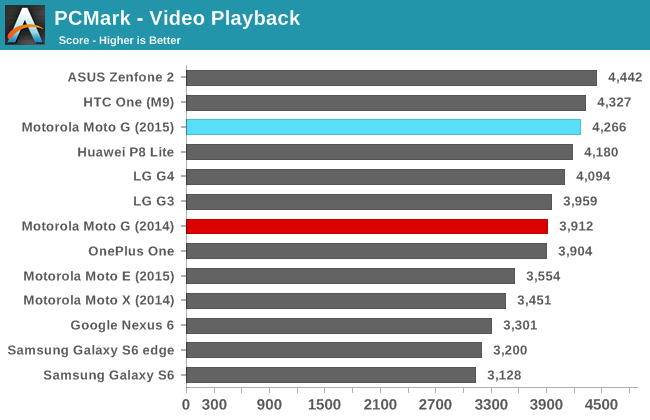
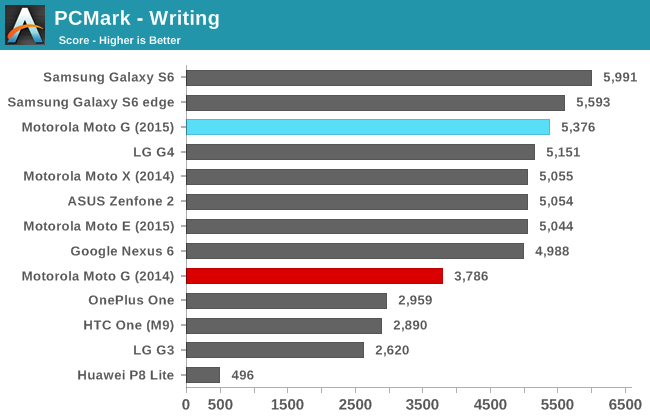
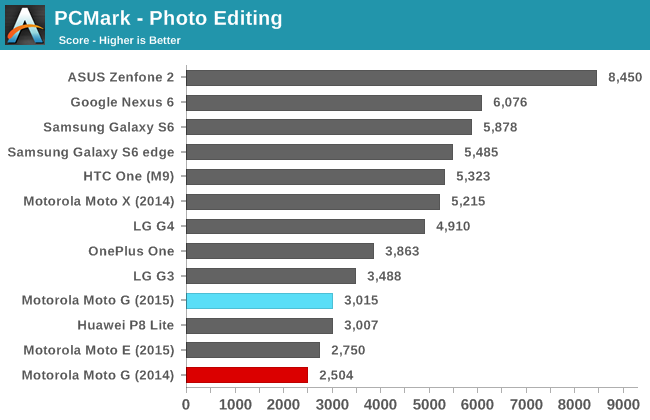
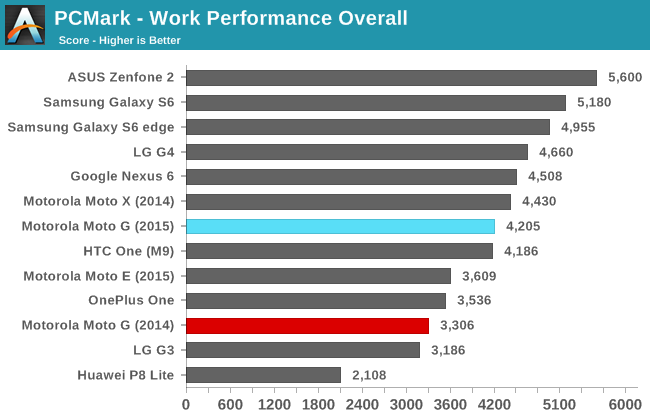
In PCMark, which focuses heavily on replicating real world tasks like watching video and editing photos, the 2015 Moto G again has a strong showing. Overall performance actually sits about the HTC One M9, carried by high scores in the writing and video playback tests. Web browsing performance also improves significantly from the 2015 Moto E and the 2014 Moto G, which could either be the result of additional memory or further optimizations to the Android WebView.
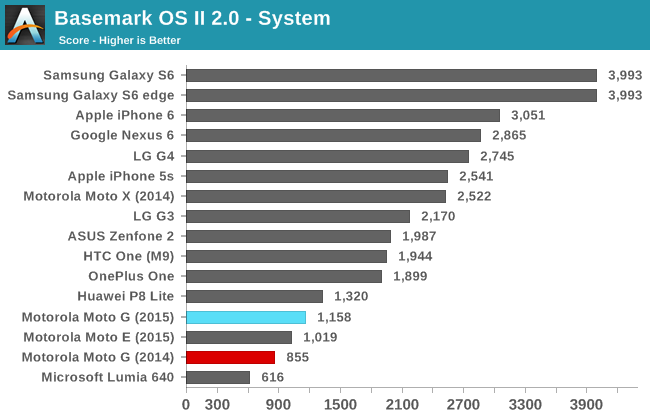
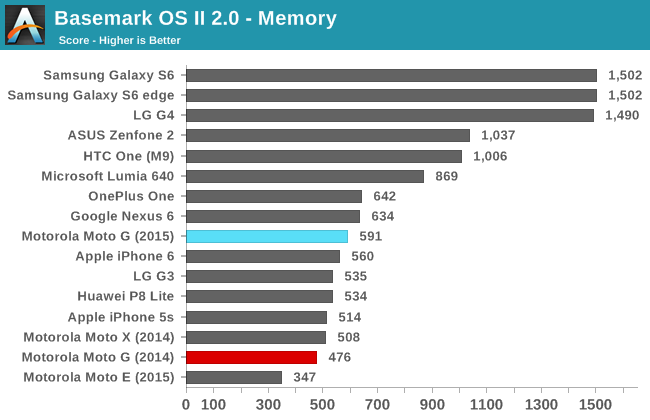

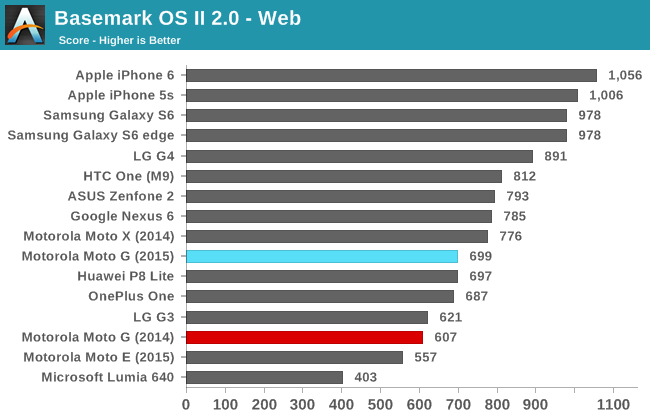
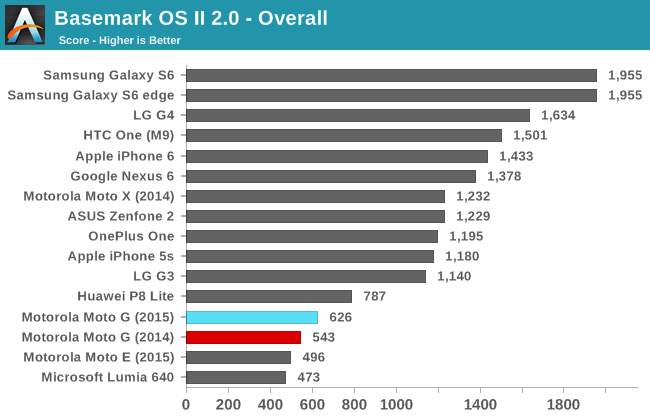
The Moto G doesn't perform as well in BaseMark OS II as it does in PCMark. While there's still good performance in the web and NAND memory sub-tests, performance lags in the system sub-test which stresses CPU and memory, and the graphics test score is very low due to how slow the Adreno 306 GPU is.
The Moto G's general performance is pretty good for a device of this price. There's a good level of improvement over the Moto E's performance, with the gap between the new Moto G and the 2014 model being even larger. The ASUS Zenfone 2 still has the best performance of a $200 smartphone, but it's something of an anomaly, and barring it the Moto G provides the best general performance that you'll see at this price point.










90 Comments
View All Comments
ipkh - Wednesday, August 19, 2015 - link
Can you measure minimum brightness? I like to use my phone at night and an idea of how dim these phone screens can get would be helpful.hzhackenbush - Wednesday, August 19, 2015 - link
I wish the new Moto G supported VoLTE and T-Mobile's band 12. The only non-flagship, less expensive phones T-Mobile does support for this functionality are not very good values relative to all the phones without it, like the new Moto G, ZenFone 2, Idol 3, etc. The $100 T-Mobile Lumia 640 does support VoLTE and LTE band 12 (and Wi-Fi Calling 2.0), but the apps I might want to run aren't available for Windows phone.Otherwise, on T-Mobile, as LTE band 12 is being rolled out now, non-LTE band 12 phones could become obsolete much sooner than phones with band 12, because the band 12 signal penetrates buildings better and travels farther in rural areas, AOTBE.
Even the iPhone 6/6+ doesn't support T-Mobile's LTE band 12. However, the T-Mobile branded Nexus 6 does (with VoLTE, Wi-Fi Calling 2.0, etc.). Hopefully the new, smaller, less expensive Nexus 5 will have those features and be sold through T-Mobile like the Nexus 6.
jabber - Wednesday, August 19, 2015 - link
Yeah I run a totally stock Nexus 4 and I can go two days easy on a charge if I don't use it like a Gameboy. This is on a nearly three year old battery.No battery gimmicks, just make sure I only keep the apps on the phone that I actually use.
Dwcdad - Wednesday, August 19, 2015 - link
Running my new moto g 3gen. Have the 2gig model. So far good little phone. At the price a great phone.StrangerGuy - Wednesday, August 19, 2015 - link
Phones like this are exactly the reason why Samsung is failing so hard to sell S6s. Far better utility, software and cheaper prices while only sacrificing marginal real world camera/SoC performance and display quality.esoel_ - Thursday, August 20, 2015 - link
Not a word on software? Is this running vanilla android? Are all motorolas still running vanilla android? Are they getting updates?Brandon Chester - Friday, August 21, 2015 - link
At this point the software situation is essentially the same on all Motorola devices so you can check out my comments in the recent Moto E 2015 review for the small changes that Motorola makes to "stock" Google Android. http://www.anandtech.com/show/9129/the-moto-e-2015...maktovic - Saturday, August 22, 2015 - link
Charging time seems wrong. The Moto G 2015 that I have charges from 0 to 100% in 2.5hrs with the charger that came along with the phoneMarkHunt - Thursday, September 24, 2015 - link
Stay away from Motorola if you want fast Android OS updates- it's a myth that they provide them quickly. When they do get round to it, they infuriatingly do it country by country over a period of months. Best get a Nexus phone.Aritra Ghatak - Thursday, December 17, 2015 - link
I know it's a bit too late but just a bit of thought on the newly launched Moto G Turbo with Snapdragon 615 A53 1.5GHz + A53 1GHz and all the rest specs matching Moto G 2015. I think this should mean a further great battery life with much enhanced graphics performance. I especially want your opinion Brandon and others' remarks are also welcome.